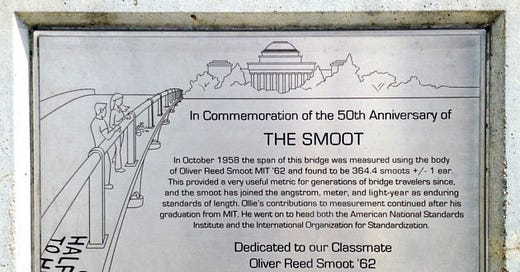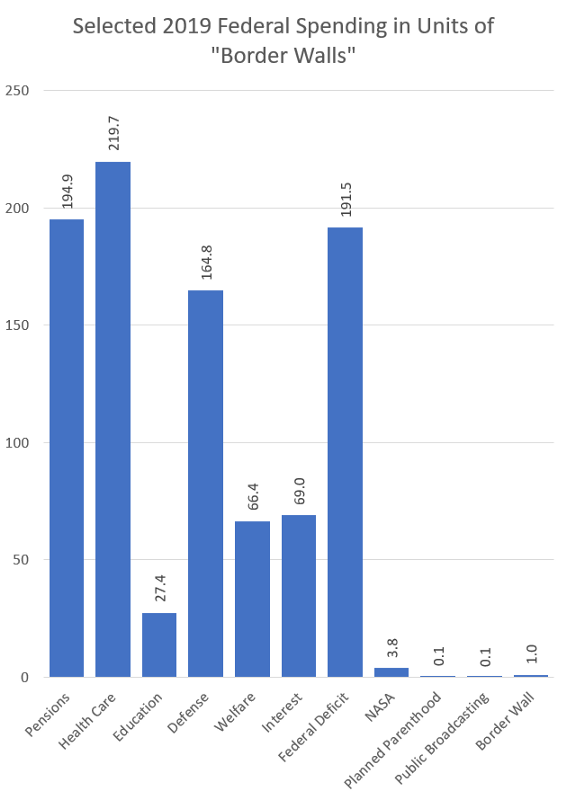The following was first published on Medium March 21, 2019
I have a hard time getting people to understand the scale of numbers. It’s a topic we’ve hit on a lot in HWFO, particularly when it comes to things like mass shooting rate. When you deal with numbers that are incredibly large, or incredibly small, the public simply doesn’t grasp them properly, because they’re quite honestly very difficult to grasp. It seems to me that this is a problem with units. A dollar simply isn’t a good unit to use, when describing federal spending, because it takes at least three of them to even buy a cheeseburger. Maybe part of the problem with the public dialog about spending is simply because we’ve chosen the wrong unit.
On Arbitrary Units
Units are arbitrary. The MIT chapter of Lambda Chi Alpha did a good example of this once, with some pledge named Smoot.
The smoot/ˈsmuːt/ is a nonstandard, humorous unit of length created as part of an MIT fraternity prank. It is named after Oliver R. Smoot, a fraternity pledge to Lambda Chi Alpha, who in October 1958 lay down repeatedly on the Harvard Bridge (between Boston and Cambridge, Massachusetts) so that his fraternity brothers could use his height to measure the length of the bridge.[1]
One smoot is equal to Oliver Smoot’s height at the time of the prank, 5 feet 7 inches (1.70 m).[2] The bridge’s length was measured to be 364.4 smoots (2,035 ft; 620.1 m) plus or minus one ear, with the “plus or minus” intended to express uncertainty of measurement.[3] Over the years the “or minus” portion has gone astray in many citations, including the markings at the site itself, but has now been enshrined in stone by Smoot’s college class.[4]
Smoot went on to become the chairman of ANSI. I wonder if the prank got him extra cred during that.
Border Walls and Green New Deals
I follow Red Feed and Blue Feed, and this gem from the Washington Times ran across my desk today:
Remember when Democrats complained that $5.7 billion for a border wall was too expensive? Well, that’s chump change compared to what many of the congressional Democrats and nearly all of those 15 declared Democrats in the presidential race are now rallying behind.
[…]
According to one recent study by the American Action Forum, the “Low-carbon Electricity Grid” proposed in the Green New Deal will cost taxpayers $5.4 trillion over 10 years, or $39,000 per household.
Similarly, a “Net Zero Emissions Transportation System,” another part of the environmental proposal, will require up to $2.7 trillion, or $20,000 per household, while guaranteed “Green Housing” would cost an additional $4.2 trillion.
The Democrat-backed welfare programs in the Green New Deal are even more daunting — according to the study, “guaranteed jobs” and “universal health care” would together cost each American family $582,000, or $80.6 trillion in total.
[…]
Added together, these preliminary Democratic proposals are projected to cost about $92 trillion over 10 years.
That got me thinking about math, because that’s pretty much what we do around here. If the numbers quoted in that article are to be believed (I haven’t vetted them) then the Green New Deal will cost the same as 16,298 Border Walls.
That’s a lot of wall. If we pretend that the border wall will cover the entire 2,000 mile stretch of the US southern border, (it won’t) then the Green New Deal expenditures could buy a wall 32.5 million miles long. That’s a third of the way from the Earth to the Sun. How do you express costs that large?
Border Walls as a Unit of Measure
What we need, is a unit that everyone’s talking about. Everyone’s familiar with. Everyone has strong opinions about, particularly when it comes to costs, so the relative size of other government programs can be expressed in numbers at a scale with which we’re more comfortable. The answer to me is obvious. Smoot our “Border Walls.”
Hereafter, 5.7 Billion Dollars is equal to one Border Wall.
I encourage all readers to start using this terminology. Maybe turn it into a movement. I can be the new president of ANSI.
Let’s express the fiscal year 2019 budget in terms of Border Walls. The military costs us 164.8 Border Walls per year. We spend 219.7 Border Walls on healthcare, 194.9 Border Walls on federal pensions, and 156.1 Border Walls on education. Federal police and fire protection cost us 7.3 Border Walls, and NASA costs 3.8 Border Walls. Interest on the debt costs 69 Border Walls every year. Planned Parenthood costs 0.09 Border Walls, and Public Broadcasting costs 0.08.
Our 2019 deficit will be 191.5 Border Walls, and our gross public debt is 3,995.7 Border Walls. That debt, by the way, would buy a border wall to the Moon and back 33 times.
I like this representation, because the big numbers and the small numbers are still within a zone that we as people find familiar and engaging. It shows us that the costs of the border wall, while tremendous, are tiny compared to other things. It also shows us that the costs associated with other programs such as Public Broadcasting and Planned Parenthood, for which there has been much wailing and gnashing of teeth, are even tinier.
Or, alternately, it shows us that the US spends a tremendous amount of goddamn money. Money that’s simply impossible for most people to visualize at all. What’s the difference between a million, a billion, or a trillion to your typical rube? Just the difference between an M, a B, or a T.
Or, even more alternately, it gives us other options for funding dialog. Like “tell the Army to build the wall out of their current outlay.” It would only cost them six tenths of a percent of their current budget to build it. Or “take the costs of Planned Parenthood out of the education budget,” which would be three tenths of a percent there. If we’re brave enough to speak in these terms, that would technically be an investment in having fewer future kids on which to have to spend money.
It also puts some of the other spending we do in perspective. Like the fact that we could balance the budget tomorrow by doing nothing more complicated than nuking the federal pension program and telling all the former federal employees to piss up a rope. “Lead balloon” wouldn’t begin to describe how that idea would be received by the general body politic, but the math is there.
I’ve just spent two paragraphs offending sacred blue and red cows with some brash ideas, and I get that. But that’s okay, we’re just talking about money. Billions or trillions of dollars of it. Border Walls of it.
All I’m really saying is this. It would be nicer if we at least understood the scale of money we were talking about.






Heh. Funny, I had that same "we can kill the deficit in one move" thought. Let the fucking leeches finally work for a living for once. (This language is predicated on that number not including military retirement. Most military people actually earned a retirement. Former DEA assholes can piss up a rope, and then hang themselves with it.)
Visualizing $100 bills in various amounts up to one trillion dollars is a fairly common YouTube animation (here’s a representative example https://youtu.be/n4-4bvuX7qA). Together, these videos may have been watched as many as 10,000,000 times—but it’s unlikely the individuals watching them are “your typical rube[s].”
So innumeracy reigns. It’s not a partisan problem, but just another aspect of rational ignorance that insures democracy will always be illusory, dangerously unstable, or both.